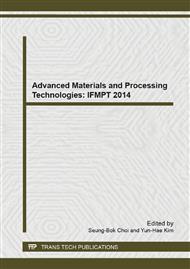[1]
P. A. Nikrityuk, K. Eckert, R. Grundmann: Int. J. Heat. Mass. Transfer. Vol. 49 (2006), p.1501.
Google Scholar
[2]
J. E. Spinelli, M. D. Peres and A. Garcia : J. Alloys Comp. Vol. 403(2005), p.228.
Google Scholar
[3]
R. S. Rerko, H. C. Groh, and C. Beckermann: Mater. Sci. Eng. A Vol. 347(2003), p.186.
Google Scholar
[4]
Z. Fan, G. Liu, M. Hitchcock: Mater. Sci. Eng. A Vol. 413–414 (2005), p.229.
Google Scholar
[5]
K. Zaïdat, N. Mangelinck-Noël and R. Moreau: C. R. Mecanique, (2007), p.330.
Google Scholar
[6]
G. Zimmermann, A. Weiss and Z. Mbaya: Mater. Sci. Eng. A. Vol. 413-414(2005), p.236.
Google Scholar
[7]
P. Mikolajczak and L. Ratke: Int. J. Cast Met. Res. Vol. 26 (2013), p.339.
Google Scholar
[8]
P. A. Nikrityuk, M. Ungarish, K. Eckert and R. Grundmann: Phys. Fluids Vol. 17(2005), p.06710.
Google Scholar
[9]
K. Galina, G. Amber and R. Lorenz: Metall. Trans. A Vol. 42A (2011), p.1657.
Google Scholar
[10]
L. S. Wang, J. Shen, Z. R. Feng and H. Z. Fu: Appl. Phys. A Vol. 113 (2013), p.177.
Google Scholar
[11]
J. Li, T. Wang, J. Xu, Z. Yan, J. Sun, J. Xu, Z. Cao and T. Li: Mater. Sci. Technol. Vol. 27 (2011 ), p.676.
Google Scholar
[12]
C. J. Zhang, V. Shatrov, J. Priede, S. Eckert and G. Gerbeth: Metall. Trans. B Vol. 42 (2011), p.1188.
Google Scholar
[13]
B. Fragoso and H. Santos: Int. J. Cast Met. Res. Vol. 26 (2013), p.193.
Google Scholar
[14]
A. L. Genau, A. C. Freedman and L. Ratke: J. Cryst. Growth Vol. 363 (2013), p.49.
Google Scholar
[15]
Z. M. Yan, W. Z. Jin and T. J. Li: J. Mater. Sci. Eng. Perform. Vol. 21 (2012), p. (1970).
Google Scholar
[16]
A. Noeppel,A. Ciobanas X.D. Wang,K. Zaidat, et at: Metall. Trans. B Vol. 41 (2010), p.193.
Google Scholar
[17]
T. Campanella, C. Charbon, and M. Rappaz: Metall. Trans. A Vol. 35 (2004), p.3201.
Google Scholar
[18]
S. Eckert, B. Willers, P.A. Nikrityuk, K. Eckert, U. Michel and G. Zouhar: Mater. Sci. Eng. A Vol. 413–414 (2005), p.211.
DOI: 10.1016/j.msea.2005.09.014
Google Scholar
[19]
M. Medina, Y. Du Terrail, F. Durand and Y. Fautrelle: Metall. Trans. B Vol. 35 (2004), p.743.
Google Scholar
[20]
Z. Chen, C.L. Chen, X.L. Wen and J. Wen: Acta Phys. Sin. Vol. 57(2008), p.6277.
Google Scholar
[21]
Z. C. Han: Electromagnetic Metallurgy, Metallurgical Industry Press, Bei Jing(2001).
Google Scholar
[22]
N. Apaydin: J. Mater. Sci. Lett. Vol. 1(1982), p.39.
Google Scholar
[23]
C. Vives: Metall. Trans. B Vol. 20B (1989), p.631.
Google Scholar
[24]
W. Kurz and D. J. Fisher: Fundamentals of Solidification, Trans Tech Publications, Switzerland – Germany – UK - USA (1984).
Google Scholar
[25]
Z. Chen, C.L. Chen, X.L. Wen, J. H. Zhu and W. S. Gao: Chin. Sci. Bull. Vol. 53 (2008), p.2575.
Google Scholar


